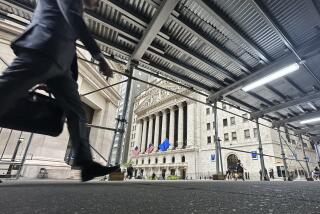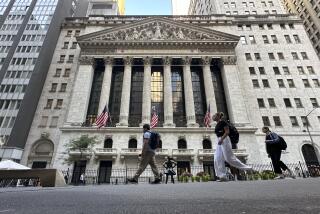Stocks pull back as global economic worries rise
- Share via
NEW YORK — Fresh worries about the global economy have investors asking whether the powerful stock-market rally that began more than three months ago is over.
A downbeat forecast from the World Bank led the Dow Jones industrials down more than 200 points, their biggest sell-off since April 20.
The decline, coming on the heels of the blue-chip index’s 3% drop last week, raises the specter that the rally that carried the Dow up more than 34% from early March has ended.
Economically sensitive sectors such as financial services and raw-material producers led the decline Monday as prices of commodities, including oil, fell sharply.
Even many bulls agree that the market was due for a breather.
“The problem with the market is we just came too far, too fast,” said David Dietze, chief investment strategist at Point View Financial Services Inc. in Summit, N.J. “There was such a return-to-risk appetite from severe risk aversion, we just got ahead of ourselves.”
However, the World Bank’s projection that the global economy will shrink 2.9% this year -- notably worse than the previous forecast of a 1.7% drop -- sparked concerns that the economy might not be mending itself as quickly or forcefully as investors had hoped.
The market rally had been fed largely on optimism that the worst-case scenario of global depression and widespread bank failures would not occur. A series of economic indicators over the last two months have pointed to a lightening of recessionary pressure.
But investors are becoming concerned that actual growth in the economy and in corporate earnings might be slower to develop than they had expected.
“For stocks to advance from here we’re going to have to see some real economic improvement, some real fundamental improvement at the corporate profit level,” said Doug Peta, an independent market strategist. “There’s a difference between getting worse more slowly and getting better.”
The Dow ended the day down 200.72 points, or 2.4%, at 8,339.01. The broader Standard & Poor’s 500 index fell 28.19 points, or 3.1%, to 893.04. The Nasdaq composite index skidded 61.28 points, or 3.4%, to 1,766.19.
Nearly eight stocks fell for every one that rose on the New York Stock Exchange.
In the commodity markets, oil futures sank $2.62, or 3.8%, to $66.93 a barrel. Less than two weeks ago they hit nearly $73.
Copper, considered a bellwether of the global economy’s health, dropped 5.3%. An index of 19 major commodities slid 2.7%.
Long-term Treasury yields fell along with stocks as the renewed doubts about an economic recovery led some investors into the relative safety of government bonds. The yield on the 10-year T-note fell to 3.69% from 3.78% on Friday.
In the stock market, skeptics about the recent rally view it as a strong burst within a longer-term bear market, not the start of a new bull market. They cite factors such as weakening trading volume and sales of shares by corporate executives and other insiders.
An average of 7.2 billion shares a day changed hands on the Big Board in March, said Phil Roth, an analyst at Miller Tabak & Co. That fell to 6.4 billion in April, 6.1 billion in May and less than 5 billion this month.
“It looks to me like we ran out of buyers,” Roth said, warning that the market could fall near or even below its March lows.
And company insiders have been net sellers of their firms’ stocks for 14 straight weeks, Dietze said. That suggests executives might not be overly upbeat about the near-term prospects of their companies.
The bottom line, some say: The economy and the market will take time to recover.
“This recession wasn’t a regular recession,” said Steven Goldman, chief market strategist at Weedon & Co. “Bridges and tunnels were knocked out this time around.”
--
More to Read
Inside the business of entertainment
The Wide Shot brings you news, analysis and insights on everything from streaming wars to production — and what it all means for the future.
You may occasionally receive promotional content from the Los Angeles Times.










